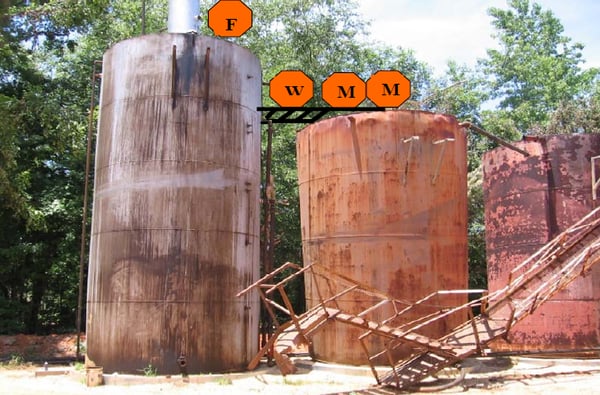On the morning of June 5, 2006, three workers were killed after a tank exploded near Raleigh, MS. We built a root cause analysis example using the information from the Chemical Safety Board's report of the accident to help understand what caused the explosion and to dig into the lessons that can be learned from it.
The day started with four contractor workers arriving at an oil well site to weld pipe connecting two storage tanks, Tank #3 and Tank #4. In preparation for this work, Tank #4 was emptied and cleaned. However, Tank #3 and Tank #2 were not emptied and cleaned. The welder used a lit oxy-acetylene welding torch to test Tank #4 for flammable vapors and no vapors were detected. The Foreman and two Maintenance Workers assisted the welder from on top of Tank #3 and Tank #4. A utility ladder was laid between Tank #3 and Tank #4 to access the pipe connection of Tank #4. The two Maintenance Workers stood on the ladder to keep it from moving.
 Photo credit: Chemical Safety Board
Photo credit: Chemical Safety Board
The ladder in the image above was drawn in to depict the ladder that was used by the welder to access the pipe connection on Tank #4. The welder used fall protection to attach himself to Tank #4 and began to weld.
Tank #2 explodes
Hydrocarbon liquid remained in Tank #2 and it heated in the morning, expanded and vapors moved through the open overflow pipe to Tank #3. Tank #3’s overflow pipe was open to the atmosphere near where the welding was taking place.
Vapors ignited, and the fire flashed back into Tank #3 and then into Tank #2, causing both tanks to explode. All of the workers were blown off the top of the tanks. The three workers that were not using fall protection were killed. The welder sustained a broken ankle and hip. Witnesses stated that the top of tank two landed about 250 yards away.
Safe hot work practices
Unfortunately, this accident could have been prevented by adhering to safe hot work practices put forth by the National Fire Protection Association (NFPA) or the American Petroleum Institute (API). Some of these recommendations include:
- Isolating the area to be welded from any piping or tanks that contain flammable or combustible liquids, vapors, or residues
- Using a flammable gas detector before and during welding
- Removing flammable or combustible liquids, vapors, and residues from tanks and all associated piping
- Ensuring that everyone involved in the work clearly understands hazards associated with welding on or near flammable material storage tanks, and the safeguards to prevent injury
Safer work procedures
Two of the fatalities may have been prevented if a proper and safe platform or scaffold had been used for the welder to access the piping on Tank #4, instead of using a ladder that required two men’s weight to hold it steady.
Lack of training
Neither the contractor nor the well site owner had established safety programs for its employees. Neither company required hot work permits. The contractor did not offer hot work safety training to its employees.
CSB recommendations
This tragic incident highlights the importance of not only having established procedures, but also training employees to follow those procedures. The Chemical Safety Board investigated this incident and made several recommendations to the contractor, well site owner, state, and federal agencies, including:
- Contractor -Develop and implement written procedures to ensure safe work practices during hot work, tank cleaning, and work at elevated locations
- Well Site Owner - Establish written health and safety performance standards and performance metrics such as those found in Recommended Practice for Occupational Safety for Onshore Oil and Gas Production Operations, API RP-74
- State Oil & Gas Board - Establish a program to identify and refer to the federal OSHA potentially unsafe health and safety conditions observed during board field inspections of well sites and drilling operations. Ensure that the program includes:
- Written procedures that define how the referrals will be implemented
- Training of field inspectors so that they are able to recognize the potentially unsafe health and safety conditions that should be referred to OSHA
- OSHA - Implement a Local Emphasis Program (LEP) to inspect companies in the oil and gas production and extraction sector
Learn more
There are many lessons learned from this tragic accident and the recommendations that can be used to prevent similar accidents in the future. The full report by the Chemical Safety Board can be found here.You can also view additional Root Cause Analysis Examples on our website.
Additional resources:















